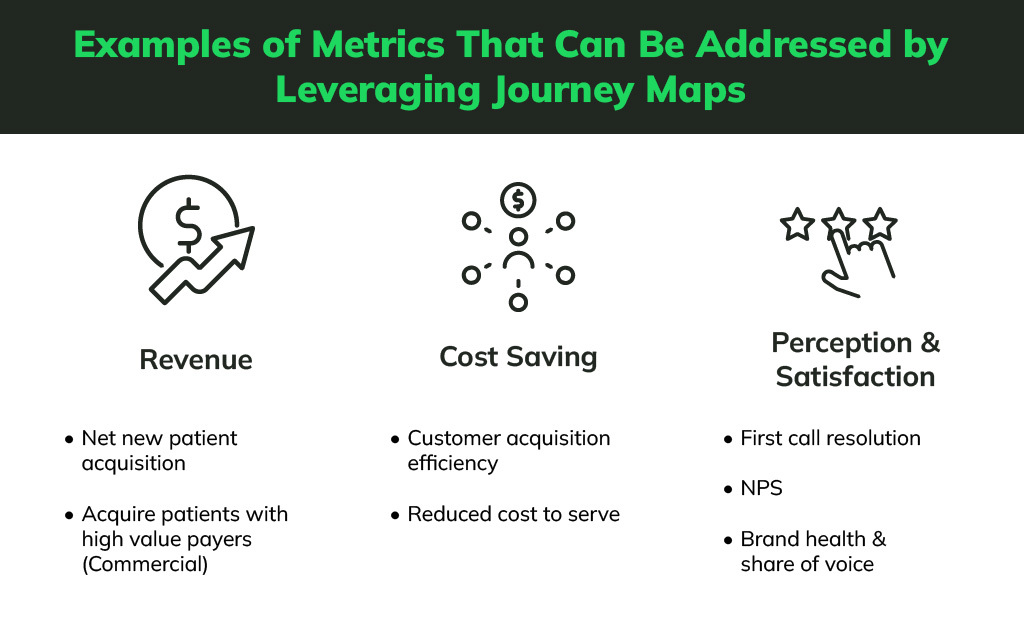In today’s consumer-driven healthcare environment, journey mapping the patient experience has a profound impact on brand reputation. In fact, according to McKinsey, companies that use tools like customer journey maps see revenues increase as much as 10-15%, while also reducing their cost of service by 15-20%.
This intersection of patient experience and brand reputation has led modern healthcare marketers to prioritize this effort, rightly understanding that consumers have come to expect seamless interactions, much like those they encounter in other industries. Healthcare marketing teams have the opportunity to lead this effort, in partnership with patient experience teams, and the positive impact extends well beyond marketing strategy.
1. It significantly impacts patient outcomes: Positive patient experiences lead to better adherence to care plans and improved health outcomes. Patients who are more engaged and informed about their healthcare tend to have better results.
2. It can reduce healthcare worker burnout: Enhancing the patient experience through seamless interactions and automation streamlines the care journey, effectively lightening the workload for healthcare staff.
3. The financial implications can be profound: Government payers (and, increasingly, commercial payers) now tie financial incentives to patient experience metrics, rewarding high ratings with bonuses and sometimes penalizing low ratings with financial losses. A decline in patient satisfaction can cost organizations millions and strain payer relationships, as payers look to optimize the performance of providers in their network. These factors emphasize the need to keep patient experience at the forefront of strategic planning.
4. It can increase patient retention: Poor patient experiences can lead to "leakage," where patients switch to competitors. Friction in the patient journey, such as scheduling difficulties and long wait times, can erode trust and impact patient retention and acquisition.
Importantly, journey mapping is best applied through a partnership between patient experience and marketing teams. Marketing teams, with their deep knowledge of customer voice, are well poised to lead the way by leveraging journey mapping as a powerful tool to optimize strategy and integrate their efforts. By identifying critical touch points throughout the patient journey, teams can tailor their marketing strategies to address specific needs and expectations at each stage.
Of course, collaboration is also key. Involving stakeholders from various other departments such as operations, IT, and patient experience can foster a comprehensive understanding of patient interactions and experiences, enabling the organization to implement holistic improvements that benefit all aspects of the healthcare journey.

To create impactful journey maps, MERGE recommends the following approach:
- Conduct thorough research to inform the journey map and avoid making assumptions
- Illustrate a comprehensive view of an “actor’s” experience (an actor could be a patient, healthcare professional, caregiver, or anyone else interacting with a system)
- Highlight actor interactions, considering their environment, emotions, goals, and motivations
- Investigate factors influencing actor decisions and perceptions
- Present data in a visually engaging story
The importance of journey mapping is underscored by people’s increasingly limited tolerance for friction, especially in comparison to smoother experiences in other industries, as out-of-category experiences color their expectations.
Enable Action
Creating journey maps that are both strategic and actionable is where many organizations falter. Often, existing maps identify emotions and moments of truth but lack actionable steps. To overcome this, MERGE recommends utilizing CX journeys as a source of knowledge and a planning tool when designing cross-channel strategies, leveraging data and technology.
Here are some examples where MERGE has used journey mapping across our provider clients to impact different types of healthcare customers:
- MERGE supported an academic medical system using journey mapping to enhance the trust and reputation in the care provided by surfacing the research expertise at optimal points in the patient consideration journey. MERGE also used a longitudinal view into the experience to create seamless pathways into participating in clinical trials, attracting high-profile researchers, and overall elevating the prominence of the organization.
- MERGE worked with a safety net hospital to improve access for people from marginalized groups and various socioeconomic backgrounds, ensuring that they adhere to the care plan, especially after an emergency department visit. This work also helped keep patients in the system for specialist and diagnostic visits.
- MERGE is supporting an integrated healthcare organization that offers both healthcare and health plans to generate organic growth between the two products by deeply understanding the journeys of patients/members, their perceptions, and trust-building factors to create real value for customers as they consider being part of an integrated health ecosystem.
- MERGE is helping an organization to enhance its value proposition to full-time and travel/per diem nurses to overcome staffing shortages, by deeply understanding the nurse journey from awareness to onboarding.
- MERGE is supporting a network of clinics in enhancing the visit experience by understanding the entirety of the touchpoints patients come into contact with before, during, and after the visit. By taking this longitudinal view, we’re able to improve the overall experience – whether it entails digital spaces, human, print, or even the five senses.
The Wrap
At MERGE, we work with our clients to define specific journeys and use cases for various segments that will help serve as foundational intelligence to engage multiple stakeholders, provide an astute focus on the customer (versus an organization), as well as bring a level of customer insight that can break down some of the unintentional silos within our organizations.
If you'd like to better understand the benefits and approach to high-quality journey mapping that is high-functioning, we're here to connect!
*Kellie Bliss, MERGE EVP, Client Service, also contributed to this article

